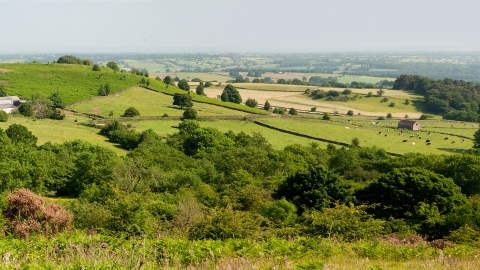Know before you go
Dogs
When to visit
Opening times
Open at all timesBest time to visit
June to JulyAbout the reserve
Highlights
To see the site’s unique flora at its best visit during the summer – although if you want to catch one of the county’s finest displays of mountain pansies you’ll need to drop by in late spring too!
Hares are frequently seen around the reserve - if you walk quietly around the trail you may disturb one lying in the grass. Look out for the characteristic black tips on the ears.
If you’re interested in history and industrial archaeology then the various ‘lumps-and-hollows’ at Thorswood provide evidence of how man has influenced this landscape.
Something for everyone
Whether you’re interested in wildflowers or landscape history, looking for a picnic spot, or just want to enjoy a quiet walk, then Thorswood is the ideal place. Amongst the 150 acres of Thorswood nature reserve you will find rare plants, flower rich meadows, heathland, iron age barrows, evidence of historic mining activity and spectacular landscapes.
Flowers, flowers everywhere!
It’s the lush hay meadows and flower-rich limestone grassland that are some of the most precious habitats to be found at Thorswood. The meadows are found on the deeper soils of the low lying ground. These fields can be identified by their tall grasses and flowering plants such as knapweed, devil’s-bit scabious, ox-eye daisy and betony. Being located on flatter ground makes these parts of the reserve more easily accessible with farm machinery, which means the meadows can be mown for hay in late summer.
The higher ground provides spectacular views over the surrounding area. The thin soil and underlying limestone rocks mean that you will find a very different range of plants in this part of the reserve. The vegetation is densely packed with low-growing flowering plants such as wild thyme, salad burnett, cowslips and early purple orchids. The patches of grassy land dotted amongst these flowers indicate the rock is acidic sandstone. Unusual plants such as mountain pansy and moonwort thrive in these areas.
The real site managers?
Unimproved, flower rich grasslands like the ones at Thorswood have declined dramatically over the past 60 years. Many grasslands have become less diverse due to intensive farming practices – fields have been ploughed up and reseeded with single species of grass, sprayed with chemicals or simply overgrazed by too many cattle and sheep.
Ironically, farming is also crucial in helping us to protect the special interests at Thorswood - but a different kind of farming. No chemicals, no reseeding, no overstocking – just light grazing and traditional farming techniques. With the help of local farmers, grazing animals are being used to benefit the wildflowers. Some fields are used to make hay which allows wildflowers to set seed before mowing in late summer. The hay also benefits the farmers by providing winter fodder for the animals when there is no new grass growth. Without grazing or mowing the more vigorous grasses would become rank and overgrown and smother the more delicate flowering plants.
Take a break
Why not walk to the highest part of the reserve and take a well-deserved rest on the unique circular stone seat. The seat was designed and built with the help of local school children and volunteers. On your way back please don’t forget to let us know your thoughts about Thorswood by filling in our visitors book.
Be aware
There has been extensive mining activity at Thorswood. In the interests of public safety we therefore ask visitors to observe any access restrictions and keep to the way-marked routes where indicated.
A Living Landscape
This nature reserve is part of the Churnet Valley Living Landscape
'Living Landscapes' is The Wildlife Trusts innovative approach to nature conservation and involves focusing our efforts on improving the wider landscape to make it better for wildlife. Find out more here
Species
Habitat
Contact us
Environmental designation
Conservation grazing is an important part of our land management at Thorswood Nature Reserve, however with open access to the Tinsell Brook the cows were contaminating the watercourse.
To prevent this, and improve the water quality, we've recently had a new bridge built over the brook for them to use as a crossing point.
Here you can see how the bridge took shape. A fantastic job by our contractors and an improvement for our aquatic wildlife in the brook! The bridge was constructed using locally sourced limestone from a nearby quarry, so it's in keeping with the local area.
This work was completed as part of our Wilder River Churnet project, which is funded by the government's Green Recovery Challenge Fund. The fund is being delivered by The National Lottery Heritage Fund in partnership with Natural England and the Environment Agency.










